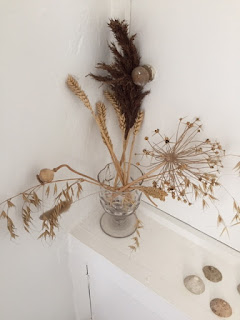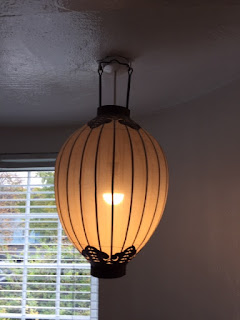Kettle's Yard in Cambridge is well worth a visit, the galleries have been revamped and show wonderful exhibitions, but the point for me of visiting the place is to look round the beautiful house filled with the most wonderful objects, paintings and plants. As you look round, you can imagine it was a home, although with all extraneous 'stuff' of living removed. The house is very much as Jim Ede, who created it, wanted it to look, having lived there with his wife Helen, I wonder what part she played in the curation of the house? I am going to quote text from the website because it expresses the look and feel of the place much better than I can do.
' In a quiet corner of Cambridge, overlooking St Peter’s Church, is a beautiful house filled with beautiful objects, once the home of H.S (Jim) Ede and his wife Helen.
Between 1958 and 1973 Kettle’s Yard was the home of Jim and Helen Ede. In the 1920s and 30s Jim had been a curator at the Tate Gallery in London. Thanks to his friendships with artists and other like-minded people, over the years he gathered a remarkable collection, including paintings by Ben and Winifred Nicholson, Alfred Wallis, Christopher Wood, David Jones and Joan Miró, as well as sculptures by Henri Gaudier-Brzeska, Constantin Brancusi, Henry Moore and Barbara Hepworth.
At Kettle’s Yard Jim carefully positioned these artworks alongside furniture, glass, ceramics and natural objects, with the aim of creating a harmonic whole. His vision was of a place that should not be
“an art gallery or museum, nor … simply a collection of works of art reflecting my taste or the taste of a given period. It is, rather, a continuing way of life from these last fifty years, in which stray objects, stones, glass, pictures, sculpture, in light and in space, have been used to make manifest the underlying stability.”
Kettle’s Yard was originally conceived with students in mind. Jim kept ‘open house’ every afternoon of term, personally guiding visitors around his home. In 1966 he gave the House and its contents to the University of Cambridge. In 1970, three years before the Edes retired to Edinburgh, the House was extended, and an exhibition gallery added. The House is by and large as Jim left it. There are artworks in every corner, and there are no labels.'
I took lots of photos which I'll share here, although the website has much better ones.
I've taken a few photos of the furniture and the way it was arranged with pebbles, and freshly picked bunches of flowers in season, there's a lovely article about the flowers here
The one above is a classic one often used on the front of books, featuring Jim Ede's Spiral of Stones, there are 76. I also like the dining table below put into the smallest of spaces
I took another photo of the plates arranged above the pictures on a plate rack, I like both views of the table
In the adjoining room there's also another table with pebbles arranged according to colour.
This flower display of Clemtais in a vase was exquisite
and nearby there was this painting which I loved
There were also lots of Alfred Wallis paintings everywhere
and the dried flower and grasses arrangements also were very inspiring. I had mine all grouped together boringly under the stairs, they are now spread out throughout the house.
Loved this Alfred Wallis as well
And this light fitting gave an exotic feel to the house.
There is something wonderful about the way the house plants, all in perfect condition, have been arranged at the 2 windows seen below
What a good idea to put shelving at the window, otherwise there's quite a lot of wasted light which could be enjoyed by plants. I must look into this.
This painting below is 'Roman Road (Landscape with Two Houses)', painted in 1926 by Winifred Nicholson. If you click on the fabulous website link, you can see a better photo of the painting and lots of information about it.
Further along upstairs in the house, there's a whole wall of Alfred Wallis paintings
and then from there, you can go to a downstairs room
where there's lots more art and wonderful artefacts
What a wonderful place to visit.
There's also lots to see in the galleries and shop, but the house is my favourite place.
I really liked this sentiment and positioning by the gallery:
and this recruitment poster from 1915, courtesy of the National Army Museum in London.
' In a quiet corner of Cambridge, overlooking St Peter’s Church, is a beautiful house filled with beautiful objects, once the home of H.S (Jim) Ede and his wife Helen.
Between 1958 and 1973 Kettle’s Yard was the home of Jim and Helen Ede. In the 1920s and 30s Jim had been a curator at the Tate Gallery in London. Thanks to his friendships with artists and other like-minded people, over the years he gathered a remarkable collection, including paintings by Ben and Winifred Nicholson, Alfred Wallis, Christopher Wood, David Jones and Joan Miró, as well as sculptures by Henri Gaudier-Brzeska, Constantin Brancusi, Henry Moore and Barbara Hepworth.
At Kettle’s Yard Jim carefully positioned these artworks alongside furniture, glass, ceramics and natural objects, with the aim of creating a harmonic whole. His vision was of a place that should not be
“an art gallery or museum, nor … simply a collection of works of art reflecting my taste or the taste of a given period. It is, rather, a continuing way of life from these last fifty years, in which stray objects, stones, glass, pictures, sculpture, in light and in space, have been used to make manifest the underlying stability.”
Kettle’s Yard was originally conceived with students in mind. Jim kept ‘open house’ every afternoon of term, personally guiding visitors around his home. In 1966 he gave the House and its contents to the University of Cambridge. In 1970, three years before the Edes retired to Edinburgh, the House was extended, and an exhibition gallery added. The House is by and large as Jim left it. There are artworks in every corner, and there are no labels.'
I took lots of photos which I'll share here, although the website has much better ones.
I took another photo of the plates arranged above the pictures on a plate rack, I like both views of the table
In the adjoining room there's also another table with pebbles arranged according to colour.
This flower display of Clemtais in a vase was exquisite
and nearby there was this painting which I loved
There were also lots of Alfred Wallis paintings everywhere
and the dried flower and grasses arrangements also were very inspiring. I had mine all grouped together boringly under the stairs, they are now spread out throughout the house.
Loved this Alfred Wallis as well
And this light fitting gave an exotic feel to the house.
There is something wonderful about the way the house plants, all in perfect condition, have been arranged at the 2 windows seen below
What a good idea to put shelving at the window, otherwise there's quite a lot of wasted light which could be enjoyed by plants. I must look into this.
This painting below is 'Roman Road (Landscape with Two Houses)', painted in 1926 by Winifred Nicholson. If you click on the fabulous website link, you can see a better photo of the painting and lots of information about it.
Further along upstairs in the house, there's a whole wall of Alfred Wallis paintings
and then from there, you can go to a downstairs room
where there's lots more art and wonderful artefacts
What a wonderful place to visit.
There's also lots to see in the galleries and shop, but the house is my favourite place.
I really liked this sentiment and positioning by the gallery:
and this recruitment poster from 1915, courtesy of the National Army Museum in London.


















Comments
Post a Comment